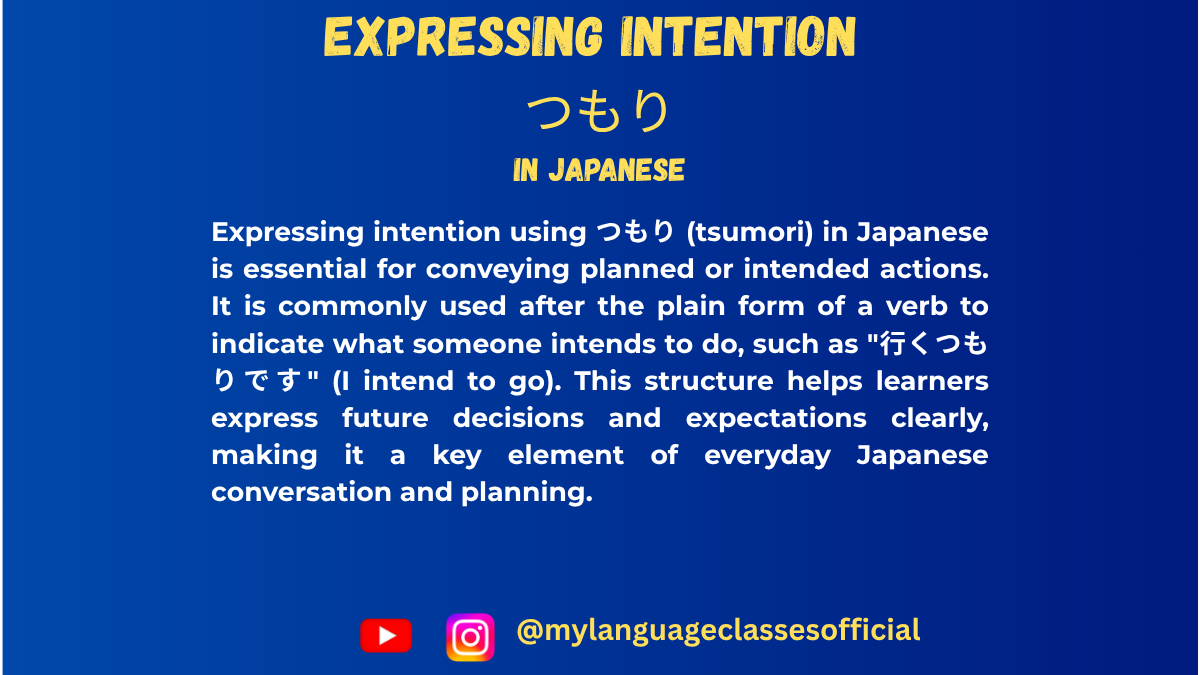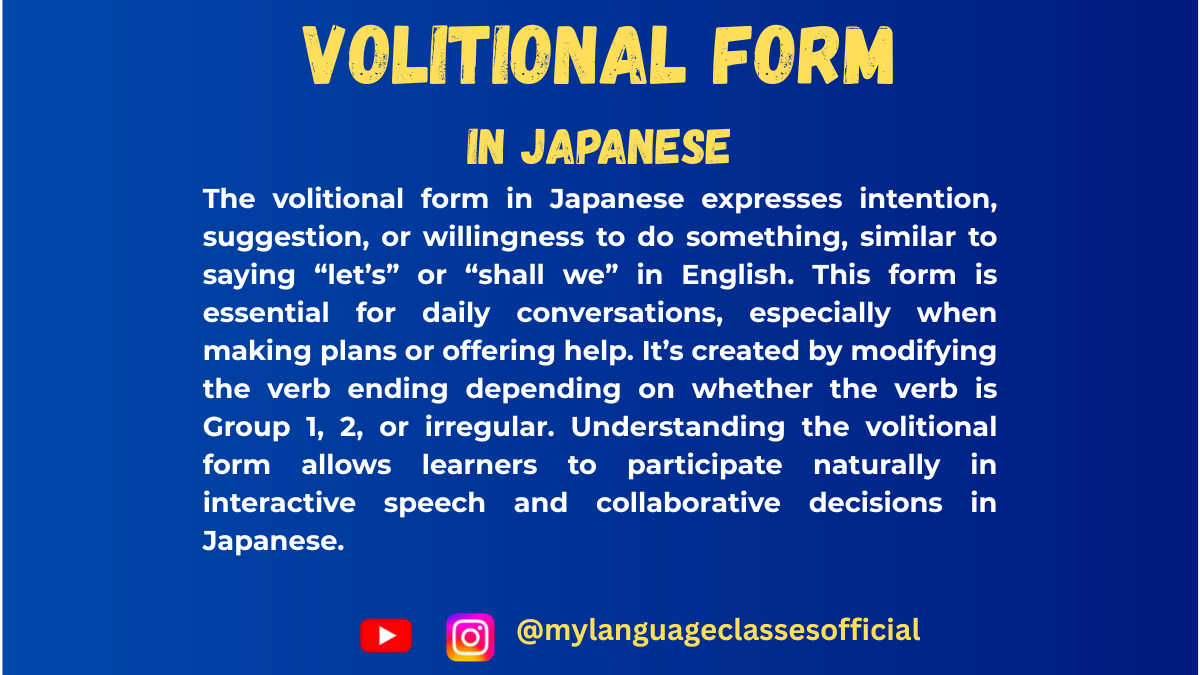Your cart is currently empty!
Tag: bible
-

Expressing Intention in Japanese:つもり| My Language Classes
How to Show Intention in Japanese
When learning Japanese, understanding how to articulate intentions or plans is crucial. One of the most common and versatile expressions for this purpose is 〜つもり (tsumori). This post explores the usage of 〜つもり, its nuances, and the various situations where it can be employed.
What is 〜つもり?
〜つもり is a grammatical structure used to express one’s intention, determination, or a plan to do something. It can also convey assumptions or beliefs in certain contexts. The term “tsumori” itself translates to “intention” or “plan.”
The construction is relatively simple:
[Verb in dictionary form] + つもりです – Intend to do something.
[Verb in nai-form] + つもりです – Intend not to do something.
How to Use 〜つもり?
1. Expressing Future Intentions
You can use 〜つもり to clearly state your plans for the future:
- 私は明日学校に行くつもりです。 – I intend to go to school tomorrow.
- 私は歌をうたわないつもりです。 – I intend not to sing a song.
2. Talking About Assumptions
〜つもり can also indicate a belief or assumption about a situation, often with an implied contrast to reality:
- 私は深く理解しているつもりでした。しかし…。 – I thought I understood it deeply, but…
This usage typically involves a past-tense verb and often reflects a misunderstanding.
3. Expressing Unintentional Actions
Although rare, 〜つもり is used to deny responsibility when you didn’t intentionally perform an action:
- それを言うつもりはなかった。 – I didn’t mean to say that.
Politeness Levels
〜つもりです is a polite expression suitable for formal and semi-formal settings. In casual conversations, you can drop です:
- 明日行くつもり。 – I plan to go tomorrow.
Adding 「つもりだよ」 or 「つもりだけど」 softens the tone even further.
Key Situations for Using 〜つもり
Here’s a comprehensive list of contexts where 〜つもり is commonly used:
- Future Plans:
- 私は明日山に行くつもりです。 – I intend to go to the mountains tomorrow.
- Negating Intentions:
- 今年は流行の服を買わないつもりです。 – I don’t plan to buy trendy clothes this year.
- Explaining Changes in Plans:
- 行くつもりだったけど、天気が悪くなりました。 – I intended to go, but the weather turned bad.
- Making Assumptions:
- 自分は結婚しないつもりでしたが…。 – I assumed I wouldn’t get married, but…
- Unintentional Actions:
- あなたを傷つけるつもりはありません。 – I didn’t intend to hurt you.
- Future Determination:
- もっと勉強するつもりです。 – I am determined to study harder.
Common Mistakes to Avoid
- Misinterpreting 〜つもり as a Promise: While 〜つもり expresses intention, it doesn’t guarantee that the action will happen. Avoid confusing it with words like やくそく (yakusoku – promise).
- Using 〜つもり in Commands or Requests: 〜つもり cannot be used to make requests or issue commands.
- Overusing in Formal Writing: In highly formal contexts, more precise expressions like 計画しています (“I am planning”) may be more appropriate.
Practice Examples
Try constructing sentences using 〜つもり in different situations. For instance:
- 私は今年日本語を終わらせるつもりです。
- 私はその話を聞いたつもりですが…
By practicing various scenarios, you’ll gain confidence in using this versatile expression.
Understanding 〜つもり is a valuable step in mastering Japanese. It allows you to articulate intentions, beliefs, and assumptions effectively. Whether planning a trip, expressing a future goal, or clarifying misunderstandings, this structure adds depth to your language skills. Happy studying!
If you enjoyed this lesson, be sure to check out more posts like this on my blog at My Language Classes. Don’t forget to subscribe my YouTube channel and follow me on Instagram for the latest language learning tips and lessons. Leave a comment below to share your thoughts, or ask any questions you have about nouns.
Happy learning! 😊
-

Understanding Volitional Form in Japanese | My Language Classes
Volitional Form in Japanese
The volitional form in Japanese is a versatile and essential grammatical structure. It’s often used to express intentions, suggestions, or invitations. Think of it as the Japanese equivalent of saying, “Let’s” or “Shall we?” in English.
This post will break it down into two main categories: the informal volitional form and the polite volitional form, making it easy for learners of all levels to grasp and apply.
1. The Informal Volitional Form
The informal volitional form is used casually among friends, family, or people you’re close to. It’s the shorter, more relaxed version of suggesting something.
How to Form It
The structure depends on whether the verb is a う-verb or a る-verb. Here’s how you can form the volitional form:
- For う-verbs: Replace the final う sound with おう.
- Example:
- 行く (iku – to go) → 行こう (ikou – Let’s go)
- 飲む (nomu – to drink) → 飲もう (nomou – Let’s drink)
- Example:
- For る-verbs: Drop the る and add よう.
- Example:
- 食べる (taberu – to eat) → 食べよう (tabeyou – Let’s eat)
- 見る (miru – to see/watch) → 見よう (miyou – Let’s watch)
- Example:
- Irregular verbs: These don’t follow the usual patterns and need to be memorized:
- する (suru – to do) → しよう (shiyou – Let’s do)
- 来る (kuru – to come) → 来よう (koyou – Let’s come)
When to Use It
Use the informal volitional form in casual contexts:
- Planning something with friends:
- 映画を見よう! (Eiga o miyou! – Let’s watch a movie!)
- Deciding something for yourself:
- もっと頑張ろう。 (Motto ganbarou. – I’ll try harder.)
2. The Polite Volitional Form
For more formal situations, the polite volitional form is used. This is especially common in workplaces, public settings, or when speaking to superiors or strangers.
How to Form It
The polite volitional form follows a straightforward rule:
- Take the stem of the verb and add ましょう.
- Example:
- 行く (iku – to go) → 行きましょう (ikimashou – Let’s go)
- 食べる (taberu – to eat) → 食べましょう (tabemashou – Let’s eat)
When to Use It
Use the polite volitional form in formal or respectful contexts:
- Inviting someone politely:
- 一緒に昼ご飯を食べましょうか? (Issho ni hiru gohan o tabemashou ka? – Shall we have lunch together?)
- Offering a suggestion in a business setting:
- 次のステップを考えましょう。 (Tsugi no suteppu o kangaemashou. – Let’s think about the next step.)
3. Key Differences Between Informal and Polite Forms
Aspect Informal Volitional Form Polite Volitional Form Tone Casual Formal/Respectful Ending おう/よう Verb stem + ましょう Usage Context Friends, family Business, public, formal
4. Practice Makes Perfect!
Here are a few sentences to test your understanding. Try converting them into both informal and polite volitional forms:
- 泳ぐ (oyogu – to swim)
- 話す (hanasu – to talk)
- 勉強する (benkyou suru – to study)
Answers:
- 泳ぐ: 泳ごう / 泳ぎましょう
- 話す: 話そう / 話しましょう
- 勉強する: 勉強しよう / 勉強しましょう
By mastering the volitional form, you’ll be well on your way to expressing intentions and making suggestions naturally in Japanese. Practice using these forms in conversations, and soon they’ll become second nature. 頑張りましょう! (Ganbarimashou! – Let’s do our best!)
If you enjoyed this lesson, be sure to check out more posts like this on my blog at My Language Classes. Don’t forget to subscribe my YouTube channel and follow me on Instagram for the latest language learning tips and lessons. Leave a comment below to share your thoughts, or ask any questions you have about nouns.
Happy learning! 😊
- For う-verbs: Replace the final う sound with おう.

